| 1-1. | Collagen, Gelatin, and Collagen Peptide |

The native protein extracted from tissues such as skin, and characterized by its triple helix configuration.
[Cosmetics]
Widely used in cosmetics for its ability to retain moisture by holding water molecules in place between the strands.


the triple helix is unwound to generate single strands that can be heated to produce a sol* form and then cooled to produce a gel** form.
[Foods and Medical uses]
Used in a range of food products, including confectioneries such as jelly and gummy candy, prepared foods sold at convenience stores, pharmaceutical capsules and photographic films.


Collagen peptides: hydrolysis of gelatin by certain enzymes generates a lower molecular weight form that does not turn into a gel form**.
[Supplements]
Dietary collagen peptides were detected in the blood and were found to participate in processes involved in the maintenance of bone / joint health and skin beauty.
* Sol refers to a mobile, liquid state.
** Gel refers to a solid state.
| 1-2. | Amino acids found only in collagen |
Hydroxyproline (Hyp) is a collagen-specific amino acid not found in milk or soybean. Hydroxyproline is thought to play an important role in the triple helix structure of collagen and water retention.

Collagen is a protein having a unique amino acid sequence in which three amino acids, glycine (Gly) -amino acid X-amino acid Y, are repeated. Among them, proline (Pro) frequently appears in X and hydroxyproline (Hyp) frequently appears in Y.
Collagen is a protein which is also present in human body, and because of its excellent biocompatibility and bioabsorbability, it is widely used in the medical field. Animal-derived collagen and gelatin have long been used in artificial bones and skin. Recently, it has been used as a culture medium for iPS cells, which has attention in regenerative medicine. Collagen has a promising future as a biomaterial in medical applications.

Reference: E.D. Hay, Cell Biology of Extracellular Matrix 2nd Edition






